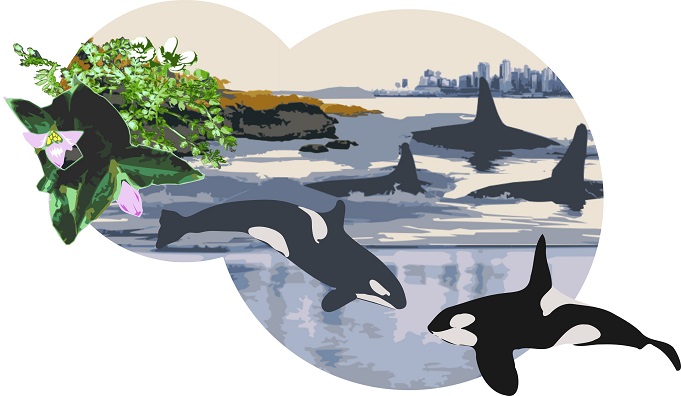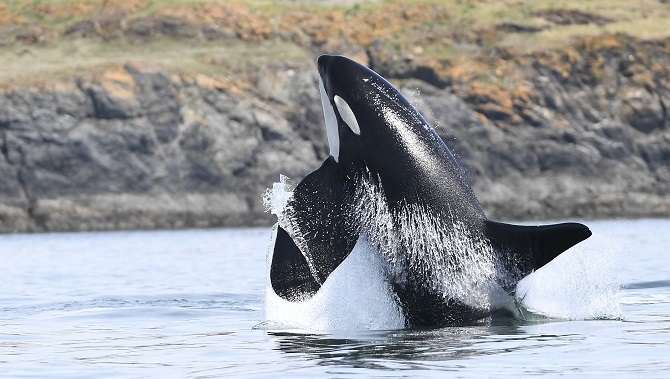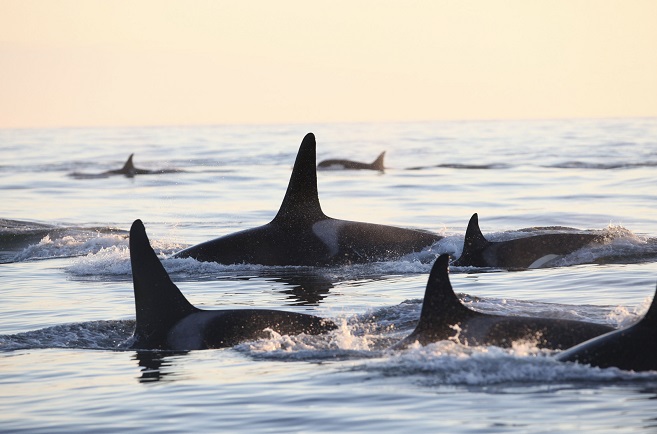Printable version (PDF - 455 kB)

The Committee on the Status of Endangered Wildlife in Canada (COSEWIC) assessed the west coast's charismatic Southern Resident Killer Whale as Endangered, as there are fewer than 75 individuals that remain. Perched above the Pacific Killer Whales’ home live two wildflowers, Hibberson’s Trillium and Macoun’s Meadowfoam, occurring nowhere else in the world. These plants were assessed as Threatened and Special Concern. Image credit: Caitlin Willier
(Ottawa, December 6, 2023). The sight of a breaching orca can be a once-in-a-lifetime experience. With a similar lifespan to humans and complex social behaviour, orcas are iconic coastal animals. At their semi-annual meeting, the Committee on the Status of Endangered Wildlife in Canada (COSEWIC) concluded that all five populations of the charismatic Killer Whale in Canada are at some level of risk.
Killer Whales are top predators, found in all the world’s oceans. Many populations have a distinct culture, dialect, and diet. Southern Resident Killer Whales on the Pacific coast mostly eat Chinook Salmon. These whales currently number 75 individuals. Dwindling Chinook numbers pose a grave threat, alongside pollution, increasing ship strikes, underwater noise, and inbreeding. The committee assessed this population as Endangered.
“These whales usually don’t have their first calf until they are 14 and only produce a surviving calf every 5 years on average,” said John Ford, COSEWIC member and Killer Whale expert. “So even if all threats stopped tomorrow, this orca population would be slow to recover.”

While still at risk, other Killer Whale populations on the Pacific Coast seem to be doing better. Although they still number fewer than 350 individuals each, both the fish-eating Northern Resident population and the seal-eating Transient population are growing, the latter benefiting from increasing seal and sea lion numbers. The Offshore population, which specializes in eating sharks, continues to occur in small numbers and may be especially threatened by contaminants. All three populations were assessed as Threatened.
Much less is known about Killer Whales in the Eastern Arctic and off the Atlantic coast. These whales likely number in the hundreds and range widely. Inuit report seeing more Killer Whales in the Arctic. As climate change causes increased environmental shifts in this region, there’s a need to research this population, which was assessed as Special Concern.
Orcas hold a special cultural significance to Indigenous Peoples, with unique names in over 13 Indigenous languages on the west coast alone. According to Larry Johnson of the Maa-nulth First Nations on the West Coast, “For us, Kakaw’in are the wolf of the sea – wolves ensure there is balance on the land and the Killer Whales ensure there is balance in the ocean. Killer Whales are messengers, they are guardians of the sea. They protect those who travel away from home and lead them back when it is time.”

COSEWIC assessed 30 different wildlife species across the country, including Ivory Gull in the High Arctic (assessed as Endangered) and Canada’s largest salamander, Manitoba Mudpuppy (assessed as Threatened; the Great Lakes/St. Lawrence River Mudpuppy was assessed as Special Concern). Back on the West Coast, perched above the Pacific Killer Whales’ home live two wildflowers, Hibberson’s Trillium and Macoun’s Meadowfoam. Both occur nowhere else in the world. Hibberson’s Trillium, a small-statured relative of Ontario’s provincial flower, grows on limestone cliffs. The meadowfoam prefers areas where light disturbance keeps invasive species at bay. For example, this plant thrives in cleared firebreaks and parks with moderate levels of recreation. The trillium was assessed as Threatened and the meadowfoam was assessed as Special Concern.
According to David Lee, Chair of COSEWIC “Our committee tries to identify all wildlife species that might be at risk, from the majestic to the minute. Science and Indigenous knowledge are an integral part of society’s commitment to safeguard Canadian biodiversity.”
Next meeting
COSEWIC’s next scheduled wildlife species assessment meeting will be held in April 2024.
About COSEWIC
COSEWIC assesses the status of wild species, subspecies, varieties, or other important units of biological diversity, considered to be at risk in Canada. To do so, COSEWIC uses scientific, Aboriginal traditional and community knowledge provided by experts from governments, academia and other organizations. Summaries of assessments are currently available to the public on the COSEWIC website and will be submitted to the Federal Minister of the Environment and Climate Change in fall 2024 for listing consideration under the Species at Risk Act (SARA). At that time, the status reports and status appraisal summaries will be publicly available on the Species at Risk Public Registry.
At its most recent meeting, COSEWIC assessed 30 wildlife species in various COSEWIC risk categories, including 10 Endangered, 10 Threatened, and 8 Special Concern. In addition to these wildlife species that are in COSEWIC risk categories, COSEWIC assessed 2 as Extinct.
COSEWIC comprises members from each provincial and territorial government wildlife agency, four federal entities (Canadian Wildlife Service, Parks Canada Agency, Fisheries and Oceans Canada, and the Canadian Museum of Nature), four Non-government Science Members, Co-chairs of the Species Specialist and the Aboriginal Traditional Knowledge Subcommittees, and two early career scientists.
Definition of COSEWIC terms and status categories:
Wildlife Species: A species, subspecies, variety, or geographically or genetically distinct population of animal, plant or other organism, other than a bacterium or virus, that is wild by nature and is either native to Canada or has extended its range into Canada without human intervention and has been present in Canada for at least 50 years.
Extinct (X): A wildlife species that no longer exists.
Extirpated (XT): A wildlife species that no longer exists in the wild in Canada, but exists elsewhere.
Endangered (E): A wildlife species facing imminent extirpation or extinction.
Threatened (T): A wildlife species that is likely to become Endangered if nothing is done to reverse the factors leading to its extirpation or extinction.
Special Concern (SC): A wildlife species that may become Threatened or Endangered because of a combination of biological characteristics and identified threats.
Not at Risk (NAR): A wildlife species that has been evaluated and found to be not at risk of extinction given the current circumstances.
Data Deficient (DD): A category that applies when the available information is insufficient (a) to resolve a wildlife species’ eligibility for assessment or (b) to permit an assessment of the wildlife species’ risk of extinction.
Species at Risk: A wildlife species that has been assessed as Extirpated, Endangered, Threatened or Special Concern.
| Dr. David Lee Chair, COSEWIC Telephone: 514-366-9574 |
For general inquiries: COSEWIC Secretariat Canadian Wildlife Service Environment and Climate Change Canada 351 St. Joseph Blvd, 14th floor Gatineau QC K1A 0H3 www.cosewic.ca |
| For inquiries on amphibians and reptiles (Mudpuppy, Snapping Turtle): Dr. Tom Herman Professor Emeritus Acadia University Telephone: 902-670-3535 |
For inquiries on arthropods (Finlayson's Oakworm Moth): Jennifer M. Heron Telephone: 604-812-8198 |
| For inquiries on birds (Gray-cheeked Thrush minimus subspecies, Horned Grebe, Ivory Gull, Yellow Rail): Dr. Richard Elliot Scientist Emeritus Environment and Climate Change Canada Telephone: 506-229-9444 |
For inquiries on freshwater fishes (Enos Lake Benthic Threespine Stickleback, Enos Lake Limnetic Threespine Stickleback, Giant Threespine Stickleback, Little Quarry Lake Benthic Threespine Stickleback, Little Quarry Lake Limnetic Threespine Stickleback, Misty Lake Lentic Threespine Stickleback, Misty Lake Lotic Threespine Stickleback, Paxton Lake Benthic Threespine Stickleback, Paxton Lake Limnetic Threespine Stickleback, Unarmoured Threespine Stickleback, Vananda Creek Benthic Threespine Stickleback, Vananda Creek Limnetic Threespine Stickleback): Dr. Margaret F. Docker University of Manitoba Telephone : 204-474-8831 Telephone : 431-336-0222 |
| For inquiries on marine mammals (Killer Whale): Dr. John K.B. Ford Scientist Emeritus Fisheries and Oceans Canada Telephone: 250-667-4698 |
For inquiries on mosses (Rigid Apple Moss): Dr. René Belland University of Alberta Telephone : 780-492-0801 |
| For inquiries on vascular plants (Cleland's Evening-primrose, Forked Bluecurls, Hibberson's Trillium, Macoun's Meadowfoam, White Wood Aster): Bruce Bennett Yukon Conservation Data Centre Telephone : 867-667-5331 Telephone : 867-689-1767 |
For inquiries on Aboriginal Traditional Knowledge: Roger Gallant Telephone: 709-638-4343 |

